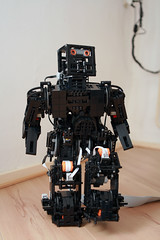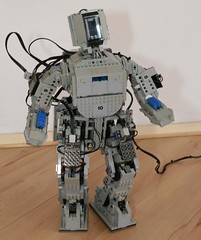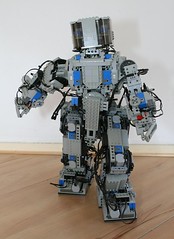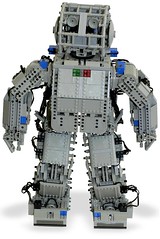Here's a short video of just one of many injection molding machines in the LEGO Billund factory. Not very glorious at this point, but the final product is simply awesome!!
Showing posts with label Lego. Show all posts
Showing posts with label Lego. Show all posts
Wednesday, December 14, 2011
Monday, October 4, 2010
SuperFail
If you haven’t figured it out yet, my current project is a Lego Sentry gun using the new (and might I add really cool) Nerf Stampede machine gun. Last weekend I spent about eight hours building the mobile base for it. I even ordered some needed parts from Bricklink before I knew whether or not it would work. I now know that it doesn’t work the way I currently have it built. I tried to give it enough power by putting two XL PF motors on each track, but that still isn’t enough. It moves fine going straight, but it won’t turn and every so often the track belts break.
I guess that is the price when you build big; your mistakes and rebuilds are big. But it looks really cool, so I thought I would show it off.
Back to the drawing board.
I guess that is the price when you build big; your mistakes and rebuilds are big. But it looks really cool, so I thought I would show it off.
Tuesday, August 3, 2010
LEGO vs. Fisher Technik
Let me start with a little disclaimer on this one, I am
writing most of this from memory. I did check
Wikipedia but that did not gave me hard facts.
In the eighties I had several types of construction toys:
LEGO, Meccano and Fischer Technic. Because of the wide range
of possibilities the only toy to survive was LEGO.
The early LEGO technic sets where great but they lacked a lot
of components we take for granted today. Some examples of these
are the worm screw gear and the pneumatic cylinder.


These are the parts we need! But wait a minute... where did
I see those parts before? Maybe some came in a set like this one
(this is a modern version):

While the LEGO robot world was still living in the stone
age the Fischer Technic guys where building stuff like this:

I think the LEGO people where "inspired" by the
Fischer Technic parts...
writing most of this from memory. I did check
Wikipedia but that did not gave me hard facts.
In the eighties I had several types of construction toys:
LEGO, Meccano and Fischer Technic. Because of the wide range
of possibilities the only toy to survive was LEGO.
The early LEGO technic sets where great but they lacked a lot
of components we take for granted today. Some examples of these
are the worm screw gear and the pneumatic cylinder.


These are the parts we need! But wait a minute... where did
I see those parts before? Maybe some came in a set like this one
(this is a modern version):

While the LEGO robot world was still living in the stone
age the Fischer Technic guys where building stuff like this:

I think the LEGO people where "inspired" by the
Fischer Technic parts...
Sunday, July 11, 2010
Building a biped: Putting it all together
After building three biped robots the goals for
the new model where:
* A good power to weight ratio: a small robot with a lot of degrees of freedom
* Fully automated calibration (I don't want to put it in a start position)
* Speed, both mechanical and software
* Strength, the robot must be able to walk
By using standard NXT motors I was able to reduce the number
of gears needed in the legs. The arms and body of the robot are
powered by power functions motors and micro motors.
The robot is fitted with 5 tilt sensors which are used to calibrate
the position of the motors in the legs. The motors in the arms use
friction gears and touch sensors to reset their position.
To control all functions of the robot three NXT bricks are used. One
brick controls six motors on the left side, one controls six motors on
the right side and one brick controls the COG shift and the head.
Bluetooth is used to communicate between the NXT bricks.
Once the hardware was finished I started programming the software.
The bricks which control the two sides of the robot each run a
state machine. The states are controlled from the master brick.
This makes it very easy to program. As long as the protocol
to communicate with the slaves does not change the slaves don´t
need to be updated, updating the master is all that is needed
to reprogram the robot.
The first routine I programmed was "standing". This might sound
strange but standing is actually a dynamic proces. The robot has
to respond to external forces like being pushed.
Just standing seems simple but it gave me some unexpected results.
When the input power of the motors was not set right the motors
started to resonate and the robot crashed.
After the standing routine was completed I extended the functionality
by programming a routine to lift the legs. The stabilization of the
legs is done with tilt sensors.
To fix the motor overshoot I implemented PID controllers. Programming a PID
controller is easy, tuning it is a different story, I am still working
on it.

Here's a video of some guys who already fixed it:
the new model where:
* A good power to weight ratio: a small robot with a lot of degrees of freedom
* Fully automated calibration (I don't want to put it in a start position)
* Speed, both mechanical and software
* Strength, the robot must be able to walk
By using standard NXT motors I was able to reduce the number
of gears needed in the legs. The arms and body of the robot are
powered by power functions motors and micro motors.
The robot is fitted with 5 tilt sensors which are used to calibrate
the position of the motors in the legs. The motors in the arms use
friction gears and touch sensors to reset their position.
To control all functions of the robot three NXT bricks are used. One
brick controls six motors on the left side, one controls six motors on
the right side and one brick controls the COG shift and the head.
Bluetooth is used to communicate between the NXT bricks.
Once the hardware was finished I started programming the software.
The bricks which control the two sides of the robot each run a
state machine. The states are controlled from the master brick.
This makes it very easy to program. As long as the protocol
to communicate with the slaves does not change the slaves don´t
need to be updated, updating the master is all that is needed
to reprogram the robot.
The first routine I programmed was "standing". This might sound
strange but standing is actually a dynamic proces. The robot has
to respond to external forces like being pushed.
Just standing seems simple but it gave me some unexpected results.
When the input power of the motors was not set right the motors
started to resonate and the robot crashed.
After the standing routine was completed I extended the functionality
by programming a routine to lift the legs. The stabilization of the
legs is done with tilt sensors.
To fix the motor overshoot I implemented PID controllers. Programming a PID
controller is easy, tuning it is a different story, I am still working
on it.

Here's a video of some guys who already fixed it:
Tuesday, July 6, 2010
Building a biped: Fixing the reset and control issues
After building the first two models and starting work on
the third model my building efforts where starting to look
like a true development program.
While experimenting with model 2 I decided that I should
reduce the complexity of the next bot to make it more
controllable.
I did not use any rotation sensors, I only used touch sensors.
The touch sensors gave me big problems, it turns out that
they work perfect when you press them at a straight angle
but when the angle is not close enough to 90 degrees they
don´t always work. To fix the problem I replaced the touch
sensors with reflective tiles and light sensors.
A single NXT brick, three sensor multipexers and three
motor multiplexers where used to control the robot.
The software was written in NXC.
Controlling this robot proved difficult. Because I replaced
the touch sensors with light sensors and used them in
combination with multiplexers they where slow to read.
Before reading a sensor value from the multiplexer you have
to give it some time to stabilize the power. This takes
about 50ms. That does not sound like a lot but the multiplexer
has 4 ports. To read all ports takes 200ms which means
you can only read your sensor values 5 times a second...
Way too slow!
Mechanically model 3 was a step down from the previous models
it was too weak to stand on one leg and the motors moved very
slow.
While experimenting with this robot I found out a simple trick
which makes it easier to shift the weight of the robot. If
the feet of the robot are angled in a way that the robot always
leans to the left or right side then the robot can select a
side to shift the weight to.

Next time: Putting it all together
Qrio... unbelievable:
the third model my building efforts where starting to look
like a true development program.
While experimenting with model 2 I decided that I should
reduce the complexity of the next bot to make it more
controllable.
I did not use any rotation sensors, I only used touch sensors.
The touch sensors gave me big problems, it turns out that
they work perfect when you press them at a straight angle
but when the angle is not close enough to 90 degrees they
don´t always work. To fix the problem I replaced the touch
sensors with reflective tiles and light sensors.
A single NXT brick, three sensor multipexers and three
motor multiplexers where used to control the robot.
The software was written in NXC.
Controlling this robot proved difficult. Because I replaced
the touch sensors with light sensors and used them in
combination with multiplexers they where slow to read.
Before reading a sensor value from the multiplexer you have
to give it some time to stabilize the power. This takes
about 50ms. That does not sound like a lot but the multiplexer
has 4 ports. To read all ports takes 200ms which means
you can only read your sensor values 5 times a second...
Way too slow!
Mechanically model 3 was a step down from the previous models
it was too weak to stand on one leg and the motors moved very
slow.
While experimenting with this robot I found out a simple trick
which makes it easier to shift the weight of the robot. If
the feet of the robot are angled in a way that the robot always
leans to the left or right side then the robot can select a
side to shift the weight to.

Next time: Putting it all together
Qrio... unbelievable:
Posted by
LegoAsimo
at
10:55 AM
Thursday, July 1, 2010
Building a biped: Another year, another robot
With the experience of the first robot I knew that the
most important thing was to make the robot light and strong
enough to allow it to stand on one leg.
The first robot (model 1) had six degrees of freedom in each
leg. I decided that I could do with four.
The new model used power functions motors combined with
RCX rotation sensors. The robot was controlled with three
NXT bricks which was not enough to control all functions
but it did allow me to experiment with the legs.
The primary goal, building a robot which could stand on
one leg was achieved.
Unfortunately by solving one problem I ran into another
problem. When you control a motor you have to know the
exact angle of the axis. To do this you have to put
the robot in a starting position of which all angles
are known. From there you can move the axis relative to
the start position.

Next time: Fixing the reset and control issues...
Here´s something fantastic...
Stuff like this used to be science fiction:
most important thing was to make the robot light and strong
enough to allow it to stand on one leg.
The first robot (model 1) had six degrees of freedom in each
leg. I decided that I could do with four.
The new model used power functions motors combined with
RCX rotation sensors. The robot was controlled with three
NXT bricks which was not enough to control all functions
but it did allow me to experiment with the legs.
The primary goal, building a robot which could stand on
one leg was achieved.
Unfortunately by solving one problem I ran into another
problem. When you control a motor you have to know the
exact angle of the axis. To do this you have to put
the robot in a starting position of which all angles
are known. From there you can move the axis relative to
the start position.

Next time: Fixing the reset and control issues...
Here´s something fantastic...
Stuff like this used to be science fiction:
Posted by
LegoAsimo
at
8:57 AM
Sunday, June 27, 2010
Trying to build a biped robot
Last week Chris invited me to contribute to Tinkernology,
and here it is... your reading my first post.
Every year I build one large LEGO model. My last model
which wasn't a robot was a Startrek model. (if you're
interested you can find it here)
About four years ago I started looking for a new building
challenge. It had to be something technical, with lots
of electric components.
What could be considered almost impossible to build?
I decided to build a biped robot...
The first goal was to just try and see how far
I would come. After studying videos and images of Hondas
Asimo robot I started building.
I used the old 9v motors combined with the RCX
rotation sensors. After working on the robot for about six
months it was finished, it had 22 degrees of freedom.
When the robot was finished it was clear that my construction
would not be able to walk. The legs could move but the robot
was too heavy to stand on one leg.
Another problem was the complexity of controlling the robot.
Because of the large number of motors and sensors I needed
eight RCX bricks to control it. It was just not practical.

So... the robot was finished, was looking pretty good but
could not walk. What should I do now, look for something
else to build? Or would it be possible to improve my design?
Next time: Another year, another robot...
The masters showing how it's done:
and here it is... your reading my first post.
Every year I build one large LEGO model. My last model
which wasn't a robot was a Startrek model. (if you're
interested you can find it here)
About four years ago I started looking for a new building
challenge. It had to be something technical, with lots
of electric components.
What could be considered almost impossible to build?
I decided to build a biped robot...
The first goal was to just try and see how far
I would come. After studying videos and images of Hondas
Asimo robot I started building.
I used the old 9v motors combined with the RCX
rotation sensors. After working on the robot for about six
months it was finished, it had 22 degrees of freedom.
When the robot was finished it was clear that my construction
would not be able to walk. The legs could move but the robot
was too heavy to stand on one leg.
Another problem was the complexity of controlling the robot.
Because of the large number of motors and sensors I needed
eight RCX bricks to control it. It was just not practical.

So... the robot was finished, was looking pretty good but
could not walk. What should I do now, look for something
else to build? Or would it be possible to improve my design?
Next time: Another year, another robot...
The masters showing how it's done:
Tuesday, December 1, 2009
Subscribe to:
Posts (Atom)



